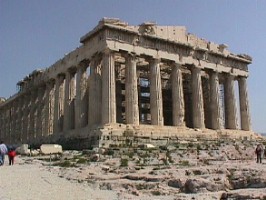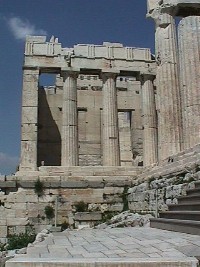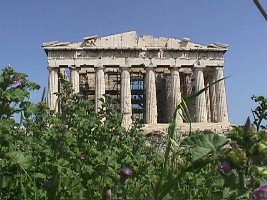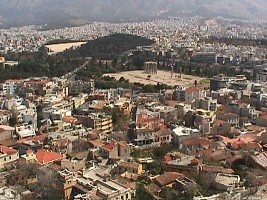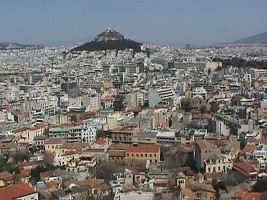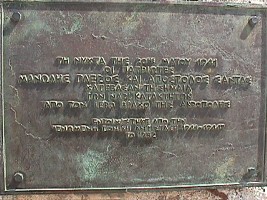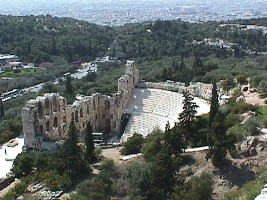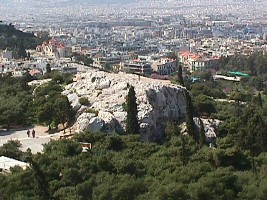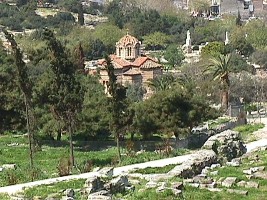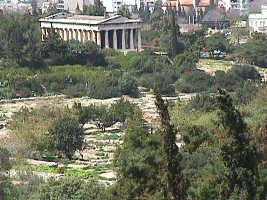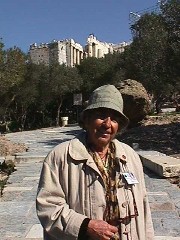The Acropolis of Athens
|
|
What would a visit to Greece be without going to the Acropolis? You can take a tour or wander up there yourself but during the summer, whatever you do, unless it is overcast, go early or late in the day. It can get very hot up there and gasping for breath can take way from your ability to marvel at the greatest of all archaeological sites. |
|
After climbing the steps you are at the entrance, or the Propylaea, which was completed in 432. Constructed in 432 just before the outbreak of the Peloponnesian wars the main architect was Mnesicles, a colleague of Phidias. To your left is the Pinacotheca and a Hellenistic pedestal and on the right the tiny temple to Nike Athena or the Athena of Victory which commemorates the Athenians victory over the Persians. Supposedly this is the place where King Aegeus threw himself into the sea because he thought his son Theseus had been killed by the Minotaur. But if this is the point he chose to jump into the Aegean then how good a king could he have been? The sea is miles away. If you looking from the propylaea towards Pireaus on a clear day you can see ships waiting outside the port of Pireaus, the islands and the mountains of the Peloponessos beyond. |
|
|
|
The
Parthenon and other main
buildings on the Acropolis
were built by Pericles in the
fifth century BC as a monument
to the cultural and political
achievements of the
inhabitants of Athens. The
term
acropolis
means
upper city and many of the
city states of ancient Greece
are built around an acropolis
where the inhabitants can go
as a place of refuge in times
of invasion. It's for this
reason that the most sacred
buildings are usually on the
acropolis. It's the safest
most secure place in town. As
little as 150 years ago there
were still dwellings on the
Acropolis of Athens. |
|
The Erecthion sits on the most sacred site of the Acropolis where Poseidon and Athena had their contest over who would be the Patron of the city. Poseidon thrust his trident into the rock and a spring burst forth, while Athena touched the ground with a spear and an olive tree grew. Athena was declared the victor and the great city of Athens was named for her while Poseidon was given a small village in Syros after it was discovered he had merely ruptured a water main. (not really).The building itself contains the porch of the maidens or Caryatids which are now copies, four of which have been placed in the Acropolis museum, hopefully to be reunited with a fifth taken from the Acropolis by Lord Elgin and put in the British Museum more than a century ago. |
|
|
|
Even having seen a thousand photographs one is still not prepared for the immensity of the Parthenon. The building was designed by the architects Kallikrates and Iktinos as the home of the giant statue of Athena. It took 15 years to build and was completed in 438 BC and is probably the most recognizable structure in the world next to the golden arches of McDonalds. From a temple it became a church, a mosque and finally as a storage facility for Turkish gunpowder. In 1687 the Venetians bombarded it from below. A cannon ball hit the gun powder and blew it up.
|
|
A question in my mind is why not rebuild the Parthenon to it's former glory? It is not as if the destruction of it is sacred history that must be preserved, in fact the 300 years since the explosion is a relatively short time-span in the history of the building. Much of the Parthenon has been taken apart and put back together with pieces being replaced or clamped to remedy the wear and tear of centuries, in particular the last 20 or so years of air pollution. As it stands now, though it is a tribute to the glorious past and the achievement of the Ancient Athenians it is also at the same time a reminder that whatever is good in man is eventually overcome by ignorance, war and a hunger for domination. I say rebuild the entire Acropolis as an inspiration that whatever is wrong with the world can be righted. (Until some idiot blows it up again). |
|
|
|
My favorite spot is at the flag where Athens stretches out endlessly below. You can see the Plaka beneath you, the temple of Olympian Zeus and the Olympic stadium nestled in a pine covered hill, an island of green in a sea of concrete. From the other side of the Acropolis you can see the Aegean and the ferries leaving for the islands. When it is clear you can see all the way to the Peloponessos. |
|
When the Germans occupied Athens in WWII, the Evzone who guarded the Greek flag which flew from the Acropolis, was ordered by the Nazis to remove it. He calmly took it down, wrapped himself in it and jumped to his death. |
|
|
|
The plaque by the flag commemorates Manolis Glezos and Apostolis Santas, the two eighteen year-old heroes who tore down the Nazi flag flying from the Acropolis on the night of May 30th, 1941. It is of particular interest because these names are known not only by Greeks, but by many Europeans, because this act of courage and resistance to Nazi oppression was an inspiration to all subjected people. Later through reading the book Athens:The City by John Tomkinson I found out that Glezos, who became a member of the Greek resistance, was condemned to death for treason in 1948 and imprisoned for being a communist. He was later elected a member of the Panhellenic Socialist Party (PASOK). |
|
Below the Acropolis is the theater of Herod Atticus built by the Romans in 161 AD and still used today for classical concerts, ballet, performances of high cultural value and Yanni. Further on is the Theater of Dionysious the first stone theater and home to Sophocles, Aeschylus, Euripides and Aristophanes. It was rebuilt around 342 BC by Lykourgos and then enlarged by the Romans to be used for gladiator fights. |
|
|
|
Below the Acropolis is the rock of Areopagos or what we called in high school 'Blow Hill'. (Don't ask). The steps are very slippery so be careful as you climb them, but once you do you won't want to come down (unless it is 100 degrees). You have a great view of the Agora, the Plaka, Monastiraki, Omonia and much of Athens. Great place to watch the sunset. Or come up at night with a bottle of wine and your true love, and watch the lights of the city. This is where Saint Paul spoke to the people of Athens in AD 51 and the tablet imbedded in the stone contains his words. There is a cleft in the rock at the bottom of the hill that is a shrine to the Furies. |
|
Afterwards, continue back around the Acropolis and down the hill into the Ancient Agora below. Part of it is free and you can go through it to get back to Adrianou Street, or you can pay the entrance fee and walk the streets of ancient Athens. If you decide to hang out awhile in the ancient Agora take a look at the rebuilt Stoa of Attalos, now a museum which features many of the every day items found in the area |
|
|
|
. The small temple known as the Thission was built in 449 BC and is virtually intact. Supposedly named for Theseus because his exploits were shown on the frieze, it is now believed that it was actually a temple to Hephaestos and Athena. Unfortunately they realized their mistake too late and the entire neighborhood is called Thission. The temple was used as a Church, dedicated to Saint George, known as Saint George the Lazy because it was only open one day of the year. |
|
You may notice at the entrance to the Acropolis and the paths leading up to it the licensed guides who for around 30 Euros or so, will give you a tour so that you may leave the area more informed then when you got here. Among them is Teresa Mitsopoulou, an Archaeologist and writer of some renown. Several of her books are considered controversial by her fellow archaeologists because they seem to prove a link between Chinese and Ancient Greek culture that if correct could change much of what we believe about the past. Theresa works as a guide on the Acropolis and a tour with her may have you questioning the past as well. She speaks 7 languages including Chinese. |
|
Thanks to Coleen for some of the Parthenon Pictures.
The Elgin Marbles: What's the Big Deal?
No doubt you have heard of the controversy surrounding the Elgin Marbles. These are the choice pieces of the frieze on the Parthenon, one of the maidens from the Erechthion and many other artifacts which were 'sold' to the British Lord Elgin by the Turks who were occupying Greece. They are now in the British Museum for 'safe keeping' though the Greek Government, the Greek people and just about everyone else in the world with the exception of the British government believe that they should be returned. To put a contemporary face on the situation if someone broke into your house, held you hostage and sold your Picasso collection to your neighbor you would expect your neighbor to return it. In this case the neighbor says "No, these are mine. I bought them."
But nothing is ever black and white so visit my website on Lord Elgin and the Parthenon Marbles which also includes more details on the history of the Acropolis and some great photos.
Be sure to sign the petition that is usually on display at a table in the Plaka.
Return to Athens Survival Guide Index
